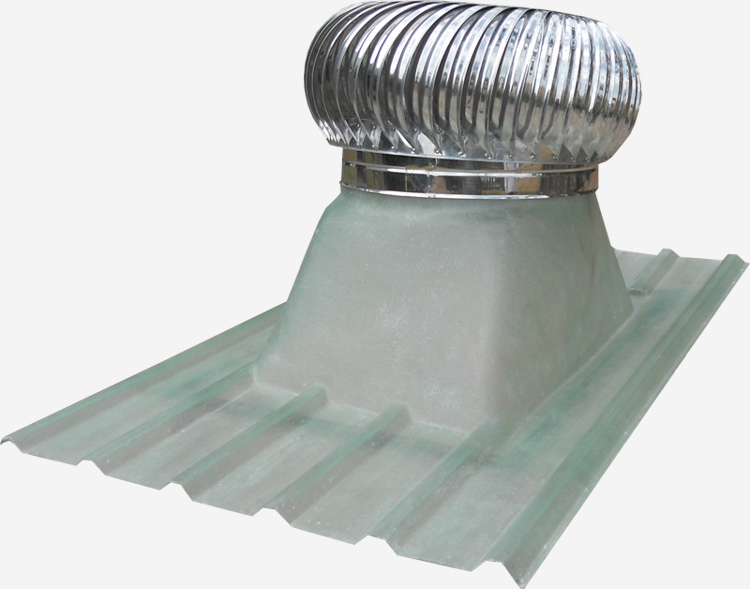 |
| VENTILATION SOLUTIONS |
| |
 |
| |
Ventilation is becoming a major concern for most industrial work places owing to fumes, gases, vapors and heat generated in production process.
A new concept of Wind Operated Turbine Air Ventilator, as a low cost environment friendly alternative against electrically operated exhaust fans, is the
best choice for industries, warehouses, commercial complexes & residences.
PRODUCT DESCRIPTION
RAW MATERIAL
1. Top plate, throat rings & shaft are made of stainless steel.
2. Fins (vanes) and supports are made of aluminium.
3. We use pre lubricated & sealed advanced UBC bearings from USA.
4. The roof dome, on which the ventilator is fixed, is made of high quality fibre glass reinforced polyester (FRP).
OPERATING THEORY:
1. The atmospheric air flow, even at a very slow speed, causes rotation of the airfoil vanes. The bearings at upper & lower end of shaft help a smooth &
noiseless rotation.
2. The rotation induces air flow by centrifugal force and sucks stale air, hot air, smoke, fumes and wet air up to the roof and exhausts them out.
3. Because of the continuous rotation, fresh outdoor air keeps entering the building thereby keeps the inside air space clean & fresh.
ADVANTAGES
1. Our Turbine Ventilator rotates with atmospheric wind flow, even at a very low speed, therefore, requires zero electric power.
2. Assured continuous nonstop ventilation.
3. 80% depreciation under Section 32 of IT Act
4. Replaces stale air, hot air, moist air, smoke and fumes with fresh air.
5. Improves human comfort level & productivity.
6. The Ventilator and FRP dome are acid resistant & corrosion free having a very long life.
7. The Ventilators are totally silent, pollution free & environment friendly.
8. The Turbo Air Ventilators are very convenient to install & can be fitted to any type of roof profile.
9. The Turbo Air Ventilators are maintenance free.
INSTALLATION
The Turbo Air Ventilator is light in weight and easily adaptable to all kinds of roofs and can be installed almost anywhere on the roof without any structural change.
QUANTITY CALCULATION
QUANTITY CALCULATION
How many ventilators are required for a particular application?
To determine the quantity of required ventilators we need to ascertain the following:
a) Volume: Volume of shed to be ventilated.
b) Air changes: Depending on the use of a particular shed to be ventilated, choose the “ number of air changes per hour” required. The following table gives guidance to determine number of air changes suitable to your application.
c) CFM of ventilator: Refer table given below.
RECOMMENDED AIR CHANGES
| Type of Building |
Air Changes Per Hour |
Type of Building |
Air Changes Per Hour |
| Assembly Hall |
6-12 |
Chemical Plant |
30-60 |
| Auditorium |
4-12 |
Laundry |
12-30 |
| Bakeries |
12-20 |
Paper Mill |
08-30 |
| Boiler Room |
15-60 |
Textile Mill |
08-15 |
| Brewery |
8-30 |
Packing Room |
08-30 |
| Class Room |
10-15 |
Transformer Room |
12-30 |
| Engine Room |
12-30 |
Paint Shop |
20-30 |
| Factories (Light) |
10-20 |
Ware House |
05-08 |
| Factories (Heavy) |
20-40 |
Foundry |
10-30 |
VENTILATOR PERFORMANCE DATA
| Wind Velocity |
8Km/Hr |
| Model |
Ventilator Size |
Height |
Exhaust Capacit |
| Turbo 24 |
24 inchs |
20 Ft |
1972 CFM |
| 30 Ft |
2076 CFM |
| 40 Ft |
2164 CFM |
TO DETERMINE NUMBER OF VENTILATIOR REQUIRED
{(Volume of shed X No. of Air Changes) / 60} / Exhaust Capacity of Ventilator.
Volume of Shed = Length X Width X Height
CONVERSIONS
1 Ft = 0.3048 Mtrs
1 Mtrs = 3.2808 Ft
1CFT = 0.028317 CUM
1 CUM = 35.315 CFT |
|
 |
|
|
|




